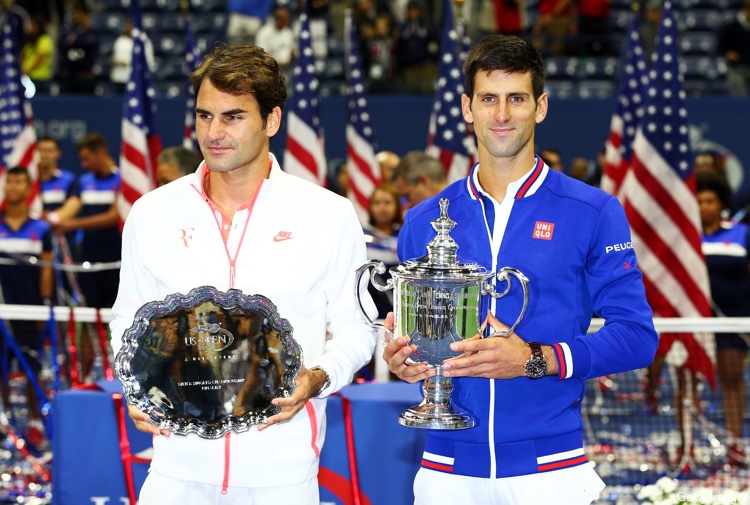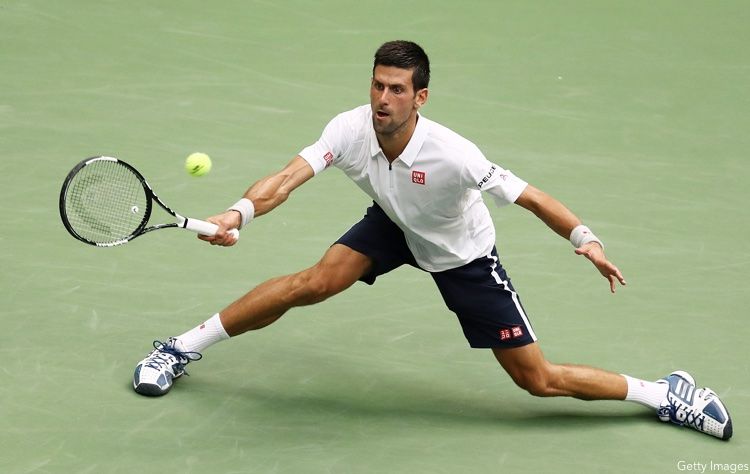Novak Djokovic will have a longer prime than Roger Federer.
Oh, no. What did you just say, Jeffrey? What are you trying to do? Are you crazy?
Hold on, one second. I can explain.
Djokovic won his U.S. Open semifinal Friday, 6-3, 6-2, 3-6, 6-2. On Sunday, Djokovic will play Stan Wawrinka in his seventh U.S. Open final, attempting to win his third title.
But this argument is not about the number of titles. It is about the length of their primes, specifically a comparison between Djokovic and Federer.
Let's start with Federer. He was a promising junior who started slow on the pro circuit. From his Grand Slam debut at the 1999 French Open at 17 to the 2003 French Open, Federer only advanced to the quarterfinals of a major twice. In fact, he only won one tournament to that point in his career (on clay, uncharacteristically).
The tide turned at Wimbledon 2003, when Federer, seeded No. 4, won his first Grand Slam. And thus began the most dominant prime in tennis history. Federer made the fourth round at the 2003 U.S. Open, won the 2004 Australian Open (to take the world No. 1 ranking away from Andy Roddick) and lost in the third round of the 2004 French Open. Over the next 23 Grand Slams, Federer won 14 titles, made 20 finals and made at least the semifinals in every tournament. Here's a handy Wikipedia screengrab to show Federer's Grand Slam timeline, which shows why he might be the best player ever.

But when did his prime end? Well, Federer started to show glimpses of his decline in 2008 and 2009. At Wimbledon 2008, Federer's five-title streak (and soon after, reign as world No. 1) ended in a five-set marathon that showed Rafael Nadal to have reached Federer's level. Nadal beat Federer again at the 2009 Australian Open, as Nadal won his third of four straight Grand Slams (stay tuned for Nadal's prime). Federer rebounded to win his first French Open, thanks to Nadal losing in the fourth round, and another Wimbledon, although, a desperate Roddick drove Federer to a 16-14 fifth set. At the U.S. Open, it was Juan Martín del Potro ending Federer's five-year reign with a five-set upset. Federer rode a cupcake draw to a 2010 Australian Open final, before a fast fade.

Federer made only two Grand Slam finals from the 2010 French Open to the 2014 French Open. He lost to Nadal in the 2011 French Open final and beat Andy Murray in the 2012 Wimbledon final (Murray beat him on the same court in the Olympic gold-medal match a month later).
Federer had a slight rebirth the past couple years, making the 2014 and 2015 Wimbledon Finals and the 2015 U.S. Open final. All three times, he was taken down by Djokovic.
It is important to note it is not like Federer became a bad player. The dude turned 35 last month but still made two Grand Slam semifinals this year in Melbourne and London. But we are talking about primes. And Federer's prime ended with his 2010 Australian Open title.
For those scoring at home, that is a prime of 27 Grand Slam. That's pretty good.
OK, now Djokovic. Like Federer, Djokovic was not a teenage prodigy. He burst onto the scene at the 2007 U.S. Open, making the final as a 20-year-old before getting wiped by Federer in three sets. He won the 2008 Australian Open final, upsetting Federer in the semifinals, but Djokovic did not return to a Grand Slam final through Wimbledon 2010. Djokovic spent about four years clearly in the bottom half of the Big Four with Murray.

Djokovic's prime opened up at the 2010 U.S. Open. And Djokovic didn't even win that tournament.
Down two sets to one against Federer, Djokovic, then mostly known in Queens for his Maria Sharapova impression, rallied. He won the fourth set 6-4 and stared Federer down to fend off two match points at 4-5 in the fifth set. Djokovic won the set 7-5 in one of the greatest matches in Arthur Ashe Stadium history. Yes, Djokovic did lose to peak Nadal in four sets, but he was clearly entering his prime right there. In August 2010, Nadal won his third straight Grand Slam and was in one of the best forms the sport has ever seen. (We'll get to Nadal, I promise.)
And then Djokovic just took off. He won three Grand Slams in 2011 and took the No. 1 ranking from Nadal. He hasn't looked back. In 24 Grand Slams, from the 2010 U.S. Open to Wimbledon 2016, Djokovic has won 11 titles, made 18 finals and reached 22 semifinals.
On Friday, Djokovic made it 19 finals in 25 Grand Slams. He can make it 12 titles in that stretch (13 overall) on Sunday. He is 29 and still in form. An arm injury has hindered him for part of this summer, notably at Wimbledon and the Olympics, but rest, thanks to opponent withdrawals, has helped Djokovic return to form in Queens. Don't be surprised if Djokovic ends his season after the U.S. Open. After all, he needs to preserve his prime.
Those 25 Grand Slams are two short of Federer's prime. Obviously nothing is a given, but with Djokovic possibly winning his third Grand Slam this year this weekend, his prime is not fading. Holding his prime for another three Grand Slams should be expected, barring an unforeseen health setback.

As his success continues, the tennis world starts tossing around the term, "greatest ever," next to his name. Of course, this always means a comparison to Federer, who played in virtually the same era, although, their primes never overlapped.
Djokovic fans should not go down the greatest of all time path. In his prime, Federer was dominant like no player ever.
Maybe it has to do with fitness or a lack of a Nadal-like foe like Federer during his prime, but Djokovic has stretched the meat of his career, and soon, that prime will be longer than Federer's term. Even if Djokovic does not get to 17 majors, he will have that over Federer.
Oh right, Nadal. And let's throw in Pete Sampras while we are at it. Each has 14 Grand Slam titles. What about their primes?
Nadal's career is as fierce as his game. His French Open dominance has to be thrown out of the equation. When we are talking about a player's prime, we are talking about his or her game on all surfaces. Nadal could probably compete at the French Open until he's 45. But on other surfaces, Nadal only had one real strong stretch. His five-set win over Federer in Wimbledon 2008 set up a run in which he won the 2009 Australian Open, 2010 Wimbledon and 2010 U.S. Open on non-clay surfaces. For much of this period, Nadal was the No. 1 player in the world and with his mix of strength and finesse, looked like another specimen.

But that was really it. Nadal has returned to a few finals, but other than an isolated 2013 U.S. Open title run, Nadal's play outside of clay fizzled out. His short-lived all-surface prime was great, but without clay, his legacy would be much different.
Sampras' career could not be more opposite. Sampras' longevity was incredible, as he won the 1990 and 2002 U.S. Open. He won seven Wimbledon crowns in eight tries from 1993-2000. But his clay court play was ugly. He made one French Open semifinal in 1996 and had three quarterfinal exits from 1992-1994. Sampras did not have much success in Australia either, winning twice in 1994 and 1997, getting a runner-up trophy in 1996 and making two other semifinals.

If we have to pinpoint a prime for Sampras, it would probably be from his 1993 Wimbledon title to his 1997 Wimbledon win. During that 17-Grand Slam stretch, Sampras won nine titles and made ten finals, although he never reached a final on clay. Sampras rallied at Grand Slams early and late in his career, but his actual prime was short-lived. The fact that he held the world No. 1 ranking 11 times shows the inconsistency of Sampras' game.
Novak Djokovic may not be the best player in terms of longevity. He may not have been the best player ever at his peak. But he does have a chance to have the longest prime of all time. And that is a legitimate career accomplishment.
-- Follow Jeffrey Eisenband on Twitter @JeffEisenband.





